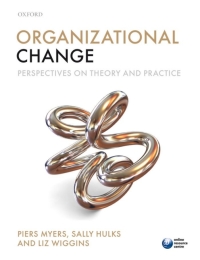The athletic footwear industry has experienced explosive growth in the last two decades. The branded shoe segment
Question:
The athletic footwear industry has experienced explosive growth in the last two decades. The branded shoe segment is dominated by a few large companies, including Nike, Reebok, and Adidas. The story of the Nike organization is often said to symbolize the benefi ts and risks inherent in globalization.
Nike was founded in 1964 by two young entrepreneurs, a track star and his coach, who wanted to improve the performance of running shoes for track competition. Hurst (2002) describes them as ‘muddling along’, testing and redesigning shoes without planning. The famous ‘swoosh’ logo was created by a graduate design student in 1972 for US $35.
A shared passion and purpose rather than fi nancial reward held together the early team. Having established itself in track shoes, Nike developed products for other sports in a highly fl exible way, with little plant or infrastructure. Hurst (2002: 41) describes the strategy as emergent through its sense of purpose—a mixture of ‘planning and opportunism in an unexploited fi eld’. Locke (2002)
notes that Nike was the fi rst to outsource shoe production to lower-cost Japanese producers.
In time, the trial-and-error approach evolved in to set ways of doing things and, as the company grew, there was a need for structure and hierarchy. Objectives and fi nancial rewards became routinized. Performance and profi ts continued to increase, although some of the early founders left the organization, perhaps ‘bored’ by its professionalization. But sustained success reinforced the appropriateness of more of the same. When Japan became an expensive source of labour, Nike moved production to Korea and Taiwan. When costs began to rise in these countries as well, it began to urge its suppliers to relocate their operations to other lower-cost countries.
However, in subsequent years, Nike was shaken by a series of scandals about the treatment of its workers, the factory conditions, poor wages in Indonesia, and the use of child labour in Pakistan. In 1996, Life magazine published an article with a 12-year-old boy stitching a Nike football. At fi rst, Nike managers tried to defl ect these criticisms, arguing that the Indonesian factories were owned and operated by independent contractors, not by Nike.
However, as pressure grew, this hands-off approach changed as Nike formulated a code of conduct for its suppliers that required them to observe basic labour and environmental/health standards. Nike created new departments, which became organized under the corporate responsibility and compliance department, with some eighty-fi ve people specifi cally dedicated to labour and environmental compliance, all located in countries in which Nike products are manufactured. It developed a new incentive scheme to evaluate and reward managers for improvements in labour and environmental standards amongst its supplier base. Nike also became actively involved in environment issues, virtually eliminating the use of petroleum-based chemicals in its footwear production and taking the initiative in organizing an industry-wide organic cotton consortium.
Today, Nike’s products are manufactured in more than 700 factories, employing 500,000 workers in fi fty-one countries.
Questions 1. Can you identify the key points of change in Nike’s history?
2. Specifi cally what changed and what do you think was the scale of that change, using Nadler and Tushman’s (1995) dimensions?
3. Read the case, applying fi rst a planned view of change. Re-read it, applying an emergent view of change. What do you notice about the application of these different views?
Step by Step Answer:

Organizational Change Perspectives On Theory And Practice
ISBN: 9780199573783,9780191512902
1st Edition
Authors: Piers Myers; Sally Hulks; Liz Wiggins





